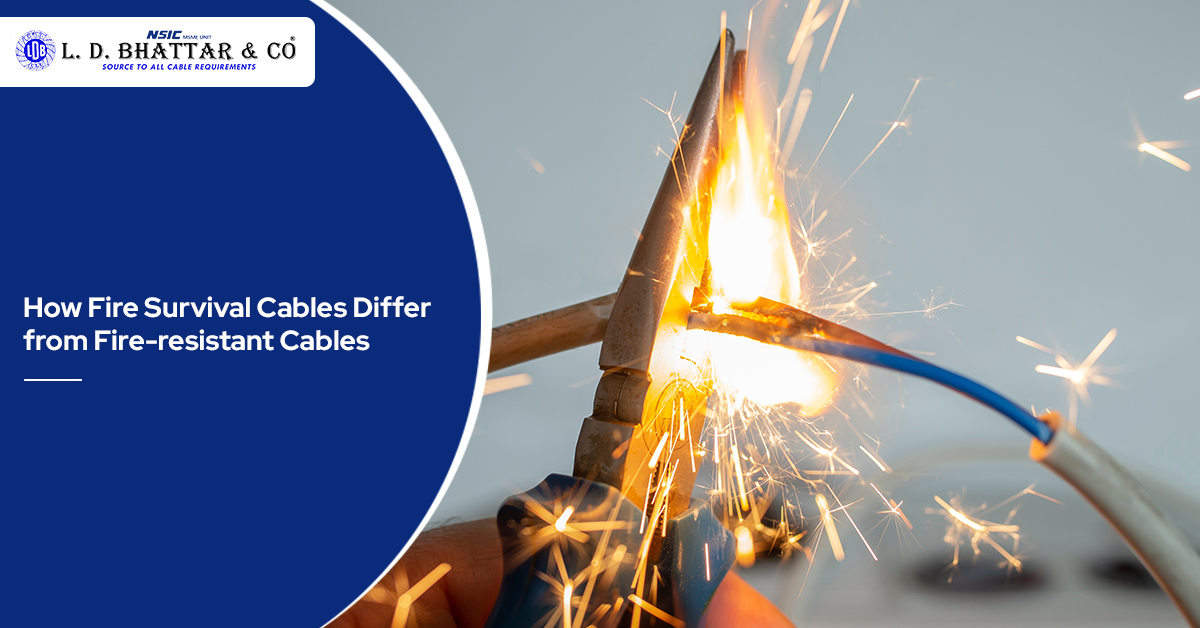How Fire Survival Cables Differ from Fire-resistant Cables

There is no doubt that when it comes to using electrical cables, fire protection is given paramount importance. This is the era of engineering and rapid construction, so if there is no fire safety in the cables used in the system, then there is a higher possibility of potentially hazardous events for human lives as well as the nearby environment.
Since there are several types of cables, it’s important to have a clear understanding of fire survival cables vs fire-resistant cables. While both types play vital roles in fire safety, they serve different purposes and have unique characteristics that make them suitable for specific applications.
Fire-Resistant Cables—Structural Defence
Fire-resistant cables are made to function under fire conditions without igniting surrounding materials. This type of cable features a copper conductor with a high melting point at 1083 °C and has a specialized fire-resistant layer incorporated between the conductor and insulation.
This layer consists of several layers of mica tape, which play a very important role in the fire resistance of this cable. Their quality and temperature tolerance directly will determine how the cable behaves when subjected to fire conditions.
Fire Survival Cables—the Protection for the Electrical System
This type of cable represents the highest level of fire protection in cable systems. These cables are provided for use in the most critical installations wherein circuit integrity must be maintained during a fire. With voltage ratings from 6 to 1000 volts, they offer several key advantages:
- Sustained functionality during fire emergencies
- Low halogen component
- High circuit integrity
- Prevention of dripping, melting, or burning
- Extended operational life under extreme conditions
These cables are particularly important in public areas or at construction sites where a power breakdown caused by fire may well result in an unnecessarily high escalation of threat to life, equipment, or structures. They are primarily meant to maintain essential services running in case of emergencies.
What are the Key Differences Between Fire-Resistant Cables and Fire Survival Cables?
Structural Composition
An important difference is revealed by the structural composition of these cables. Ordinary cables share the basic cable architecture, while fire-resistant cables have extra protective layers and special materials.
Advanced material selection and construction techniques generally secure electric functionality in achieving fire resistivity through fire exposure. Fire survival cables take it up a notch by integrating advanced materials that can sustain longer operations at extreme conditions.
Application Context
From an application perspective, fire-resistant cables are commonly used in emergency systems where temporary fire exposure is anticipated. They’re ideal for:
- Fire alarm systems
- Emergency lighting
- Critical power circuits
Fire survival cables, on the other hand, are retained only for the most critical applications where continued operation during fire conditions is required, such as emergency power supplies to evacuation systems and critical safety equipment.
Operational Capabilities
Performance requirements for these cables are also vastly different. Fire-resistant cables are designed to operate for a known period of time when exposed to fire, usually meeting a standard fire resistance rating.
However, fire survival cables, on the other hand, are designed to offer an extended operational capability under fire conditions, thus suitable for any installation where the evacuation time may take more than the permitted limit, or where the constant operation of the critical systems is required to respond to emergencies.
Get in Touch with Us!
While both fire-resistant and fire-survival cables contribute to building safety, their specific applications and performance characteristics set them apart. Understanding these differences is crucial for architects, engineers, and contractors to make informed decisions about which type to install based on the building’s requirements and safety regulations.
The choice between these cables can significantly impact the overall safety and emergency preparedness of a structure, making it essential to carefully consider their unique properties during the design and installation phases. However, if you want to purchase our products, feel free to ask us at L. D. Bhattar & Co.
